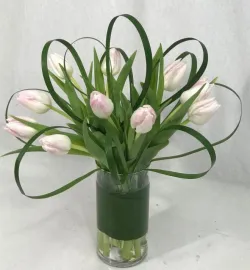Tulips might just be the most iconic flower of spring. People exclaim when they see the first signs of tulips peeking up through the ground in home gardens. Once they’re in full bloom, people head to local botanical gardens or parks to see displays of the myriad varieties. Others are excited to purchase a bouquet of tulips to bring spring into their own home as soon as possible.
First cultivated in the 11th century in Constantinople, the name “tulip” is said to have come from the Persian word for turban. Tulips, which originally grew wild across western and central Asia, naturally prefer temperate climates in mountainous regions, but with extensive cultivation and about 75 different species in existence, tulips can be grown and maintained almost anywhere with proper care.
Tulip mania swept the European market when the beautiful bloom was first introduced to that region in 1634. Many historians consider that event to be the very first asset bubble in history. Like inflation in today’s market, however, the exorbitant prices could not be maintained, and the market bottomed out on the fashionable tulip frenzy just three years later in 1637. The Netherlands has remained a major supplier of tulips (and tulip tourist destination) in the world market ever since.
These bold blooms come in a variety of colors and sizes. Warm colors like yellow, red, pink, and white are most traditional, but these days, they come in almost every color imaginable. Interestingly, color variegations were originally created by a natural virus in tulip bulbs known as the tulip breaking virus. The product of this virus created stunning variegated patterns that were highly prized. Although those types of “broken” tulips no longer exist, they have a firm place in history, as they were a favorite of Rembrandt, who featured them in many of his works.
If you enjoy brightening your home or giving others the gift of spring with arrangements filled with tulips, daffodils, and other popular spring bloomers, here are a few care tips to help those cut blooms last as long as possible.
- Be sure to keep the stems in fresh water. If you recut them, do it on a diagonal angle and be careful not to cut more than half an inch.
- Place your blooms in a clean vase.
- Although many people think cold water is best, tulips actually prefer warm water.
- Do not forget to add the floral preservatives! They feed the flowers and help prevent damaging bacteria from growing in the water.
These quick and easy tips should keep your bouquet looking fresher longer. Stop by or call the Lilygrass team today to order your arrangement. Happy spring!
lilygrass flowers and decor



